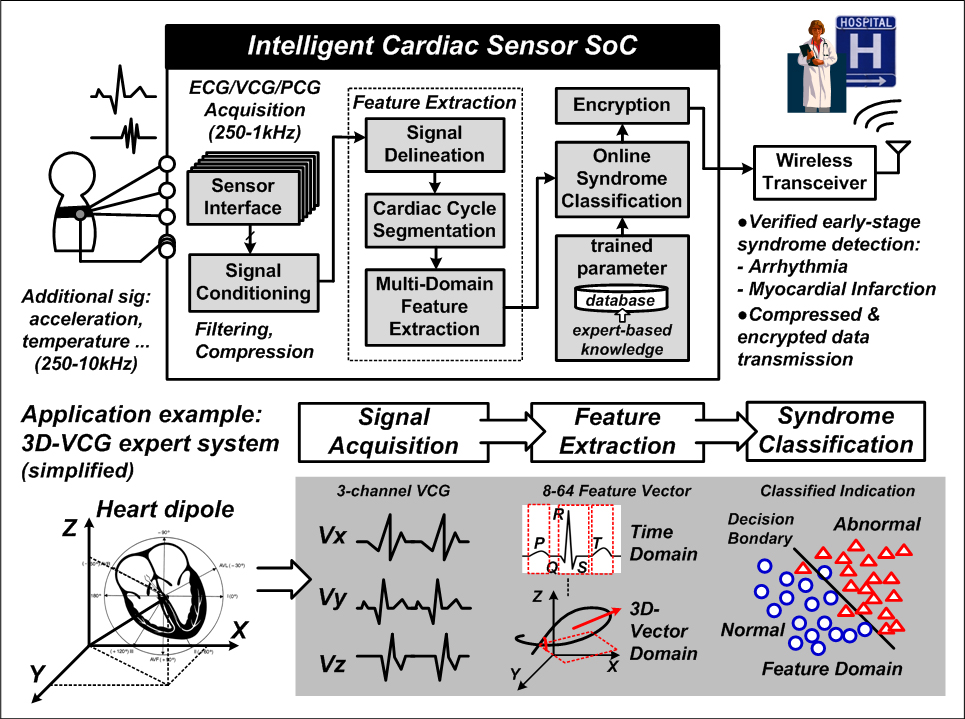A move towards mobile healthcare with medical-internet of things (IoT) devices is placed under the spotlight here in an insightful piece from Prof D. Chen-Yi Lee from Department of Electronics Engineering, at the National Chiao Tung University in Taiwan
In this article, I will be looking at the impact on society when it comes to the move towards mobile healthcare with medical- internet of things (IoT)(1), technology trends, as well as an interesting example of an electrocardiogram (ECG) and my thoughts on what the future could hold in this exciting field of research.
The impact of medical devices on society
To achieve better medical services with early diagnosis and early therapy, innovative solutions for preventative medicine have been continuously investigated and promoted to both medical centres and local clinics. One of the major driving forces in exploring these solutions for mobile healthcare is to allow limited medical resources for those patients who demand in-time treatment and medical care under the coverage of national health insurance in Taiwan.
Furthermore, both medical teams and the general public need to be re-educated before these new diagnosis/therapy solutions and inherent service models can be accepted. And even some governmental regulations have to be re-adjusted or added to allow these solutions to be deployed for practical usage.
Technology trends
The advances in wireless devices and miniaturised sensors fuel the possibilities of mobile healthcare applications, where medical-internet of things (M-IoT) devices are body-worn or implanted for continuous vital signal recording. To extend the M-IoT monitoring duration, on-sensor biomedical signal processors (BSPs) can be applied to timely extract the critical information for reduced storage and transmission data. Considering the support given to versatile applications with maximised monitoring time, the BSPs should be flexible and accurate with extremely low power operation.
In addition, single-type sensor or sensor-fusion solutions should be developed as well to generate valid bio-datasets for follow-up health conditions analysis. Data screening is key to enhance prediction accuracy and avoid false alarm in practical usage. Finally, data security to protect privacy leakage and personal identification to secure the quality of service should be taken into account in these M-IoT devices.
An example on an electrocardiogram (ECG)
An application scenario on an electrocardiogram (ECG) for heart disease prediction is illustrated in the following figure. To meet the requirements of mobile healthcare applications, a specific M-IoT device is demanded with enhanced energy-efficiency so that it can be operated for more than one week with one chargeable battery. In the meantime, the device should be small enough to allow user-friendly wearable usage. Thus, a specific chip needs to be designed to cover the following functions, namely signal acquisition, feature extraction, syndrome classification. In addition, data security and personal identification have to be covered as well.
Wireless transmission can be leveraged by those commercial solutions, such as Wi-Fi and Bluetooth depending on how this M-IoT is deployed and used. A preliminary IRB clinical trial based on this M-IoT on the prediction of both arrhythmia and myocardial infarction with accuracy over 95% have been reported. If sensor-fusion is further exploited to cover ECG, vectorcardiogram (VCG), and phonocardiogram (PCG), it is believed that prediction accuracy can be further improved.

There are two issues to be further illustrated to avoid false alarm in practical usage. One is the input signal quality and data validation: this is a very important issue if the input signal has been affected by environmental noises, such as those from power-line, skin contact drift, motion artefact, etc. Different methods have been investigated to reduce these noise sources so that signal to noise level can be further improved. However, these noise-reduction methods may also induce human-made extra noises to signal sources, leading to worse prediction accuracy and even higher false alarm rates.
As a result, new approaches to screen out valid datasets from source signals should be further studied. The other issue is datasets collection from clinical trials. The sample volumes should be large enough to cover different test conditions in model training phase so that prediction accuracy can be accepted in practical usage. This is very important when M-IoT devices are to be deployed in different test scenarios.
However, one problem often encountered is the limited datasets collected for model training, especially in medical diagnosis based on the data-driven approach. Even test samples and procedures have been well defined and planned but it’s still hard to cover all test conditions and, hence, prediction accuracy may vary a lot in practical usage. As a result, new approaches toward autonomous learning at the M-IoT device level should be further explored to enhance prediction accuracy and make it reliable for mobile healthcare applications.
A glimpse into the future
Lastly and by no means least, it is believed that with the advances taking place in M-IoT devices, including both sensing capability and autonomous learning, the penetration rate will become much fast than it is today. These new M-IoT devices, together with data-driven operation infrastructure currently under construction, will definitely provide better medical services to society. As a result, the general public will benefit more from a one-stop service platform to lead a better life while enjoying the advantages offered by those M-IoT devices, both developed and under development.
References
1, Work supported by the Taiwan Government under NSC 104-2218-E-009-007 and MOE 107W214.
Shu-Yu Hsu, Yingchieh Ho, Po-Yao Chang, Chauchin Su, and Chen-Yi Lee, ?A 48.6-to-105.2μW Machine Learning Assisted Cardiac Sensor SoC for Mobile Healthcare Applications? IEEE Journal of Solid- State Circuits, Vol. 49, No. 4, April 2014, PP. 801-811.
Prof D. Chen-Yi Lee
Department of Electronics Engineering,
National Chiao Tung University
Hsinchu, Taiwan 300
Tel: +886 357 318 49
cylee@faculty.nctu.edu.tw
http://si2.ee.nctu.edu.tw
*Please note: This is a commercial profile











